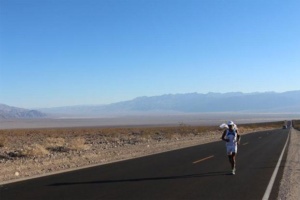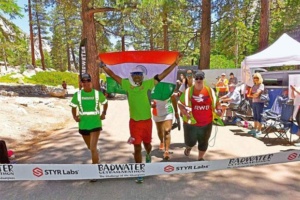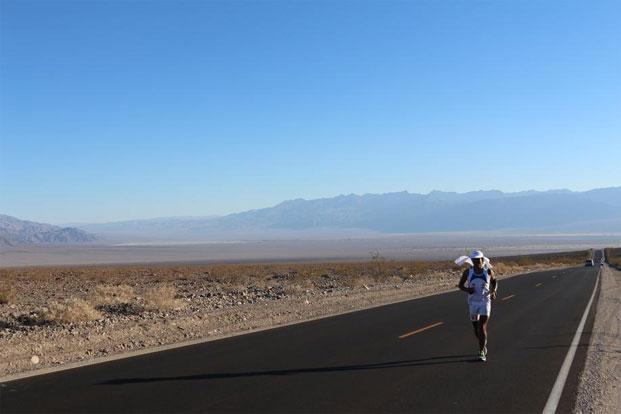Most folks would be down and out, had they endured what Brijmohan ‘Breeze’ Sharma did on Mt. Everest. However, it only urged him to come back stronger and leave a mark on the 217km, Badwater Ultra as the fastest India to finish the race.

Running the world’s
hardest race
How a navy officer took on the 217km Badwater Ultramarathon
Whenever the chips are down, Mumbai-based Brijmohan “Breeze” Sharma swears by his golden words, “Sab ho jayega (It will all work out)”.
It’s the same attitude that carried him across the finish line at the top of Whitney Portal (2,530m) on 20 July. After 40 hours and 47 minutes, the 42-year-old, who was carrying the Indian flag, had pulled off a successful run at the Badwater 135, one of the toughest ultra marathons in the world.
Started in 1987 with five runners, the single-stage race features a 135-mile (217km) course through one of the most desolate terrains of California. The run starts at 85m below sea level and sees a cumulative ascent of 4,450m through three mountain ranges. Even at midnight, the temperature is 40 degrees Celsius. Single stage essentially means the race must be completed in one go, within the cutoff period of 48 hours. Entry is by invitation, and this edition saw 97 resolute athletes. Sharma finished 56th.
For the record, just two Indians have attempted the race in the past (Arun Bhardwaj in 2011, clocking 41 hours, 6 minutes, and Piyush Shah, who did not finish, in 2014). Through two sunrises and one sunset, Sharma registered a time that made him the fastest among Indians, though he says just finishing is enough to earn him bragging rights.

What made it sweeter was that he made it there against all odds. The truth is, Sharma is lucky to just be alive.
While growing up in Harota village in the Chomu tehsil of Rajasthan’s Jaipur district, Sharma had led a life that was very different from the many interests he chases today. It all changed when he joined the Indian Navy and happened to read an article on Prajapati Bodhane, a navy mountaineer who had led an expedition to Mount Kanchenjunga in 1993.
A chance meeting with Bodhane, and Sharma had found a new passion—climbing mountains. From local treks in the Sahyadris every weekend he graduated to the enchantment of the Himalayas when he joined navy expeditions.
“I had never seen mountains while I was in Rajasthan. I faced difficulties at the start. But soon, I fell in love with nature,” he says.
In 2007, he took charge of the activities of the Western Naval Command’s adventure wing. There, he met Suresh Pillai, a Mumbai-based runner working in the navy who convinced him to take up running.
“I started my running career with the Vasai-Virar full marathon. Beers a night before the race are never a good idea; then again, I had no idea about this world of running. I started cramping after the 31km mark and finished in 5 hours, 38 minutes. But it was the start of a new journey for me,” he says.
The world of ultras followed. In 2013, he took third place in his first ultra—the 80km event at the Bhatti Lakes ultra—and realized this was his domain. Weekends were dedicated to demanding races such as the Khardung La Challenge and the Nilgiris 100, while the navy mountaineering expeditions continued. Sharma was gearing up for bigger things.
In 2015, Sharma thought he was ready for a shot at Mount Everest and the neighbouring Mount Lhotse, the fourth highest mountain in the world. That’s about the time an earthquake struck Nepal.
“No Indian had made both summits in a single attempt. I was quite determined to pull it off. I was 35 days into the expedition when I was buried by an avalanche at Base Camp and had to dig my way out of the snow. I was lucky to be alive, but my dream was shattered,” he recalls.
But that was not the end of his troubles. He was staring at a debt of Rs.25 lakh—a bank loan plus money he had borrowed from friends. And he had no achievements to show for it.
For the next six months, Sharma avoided all calls and people. He had blown up all his savings and now had to figure out a way of repaying his lenders. Running was the last thing on his mind.
“It was a huge burden, and just getting back home was a big deal. It was pretty much like playing a game of hide-and-seek,” he says.
“But after a while, I realized this was no way to live. I took another loan, sold my bikes, which included a Harley-Davidson, and started returning whatever money I could.”
To prove a point to his detractors and to himself, he decided to take on one of the world’s toughest ultras.
The Badwater 135 has stringent qualification norms—a runner should have run three 100-milers just to make the cut. After managing—and winning—the third of his 100-milers, in the Western Ghats ultra in December, he signed up for the race in January. The following month, he was invited to the run. He had something to look forward to again.
Funds were still scarce. Each month, a pair of worn-out shoes had to be thrown away and money invested in another; registration fees had to be paid, hotels booked. Once again, Sharma made his way back to the same friends he had taken a loan from and got an earful. But they relented eventually.
Training began in the sweltering, midday heat of March on the Eastern Express Highway, with onlookers sitting in the comfort of their air-conditioned cars, staring incredulously at the man waging a lone battle against the elements.
“In hindsight, training in 35 degrees Celsius in Mumbai’s humidity was of great help,” he chuckles.
He logged 900km in March; that figure rose to 1,200km in April.
On 18 July, Sharma lined up at the starting point at Badwater in Death Valley alongside some of the world’s top ultra runners. His dreams of climbing the world’s highest mountain shattered, he was staring at the dark desert road ahead.
“I had made it to the start after all the hiccups, the ups and downs. All that was left now was the race, and all I aimed for was to finish,” he says.
The first 21km were a breeze, nailed in an average half marathon time of 2 hours, 18 minutes. Sharma led the first wave that started at 8pm until the 26km mark. Realizing he was pushing too hard, he then slowed down. Once the sun was up, the temperature climbed rapidly, and, around the 60km mark, Sharma experienced what the race was all about.
“The course ran through a sea-bed of sorts. The desert spread for miles and climbed up hills in some places. It must have been over 50 degrees Celsius. The air was scorching and I ran through sand twisters. About 10 miles later, it was all uphill and I feared exhaustion and dehydration. These conditions in the middle of the day were unforgiving,” he says.
But the unforgettable moments kept him going.
“The nights were beautiful; the moon came out and lit up the desert. There was pin-drop silence; you could listen to nature. I encountered three jackals once, a sign from God that life existed here despite the inhospitable conditions. It inspired me to keep moving,” he says.
Once he hit the 100-mile mark, Sharma found himself face-to-face with a situation he had never experienced before. Whether it was the mental barrier or the physical fatigue, he had to dig deep into his reserves to get through the last 35 miles.
“I didn’t face any injuries; there was no pain. Yet I felt dizzy and just wanted to sleep. I wouldn’t have pulled through without my friend and chief crew manager Vijayalakshmi Nadar,” he says.
Nadar, who had seen two other crew members pulling out, asked her teenage daughter, Arushi, to take the wheel, and put on her running shoes. For the last 35 miles, she kept Sharma engaged with her banter and songs.
“Pyar deewana hota hai is my favourite,” Sharma smiles.
“As I crossed the finish line, I realized why they said this race had a different kind of respect among ultra runners,” he says.
Sharma is still basking in the glory of that run. But he knows the lenders will start calling up soon. This time, however, he’s ready.
With the 10 toughest ultra marathons on his radar, Sharma wants to next attempt the Marathon des Sables, in the gruelling climes of the Sahara desert. And take another shot at Everest in 2017.
“Sab ho jayega,” he says.
